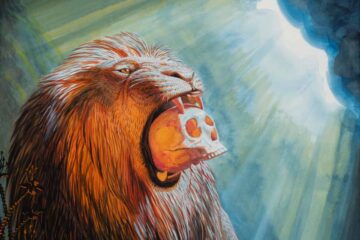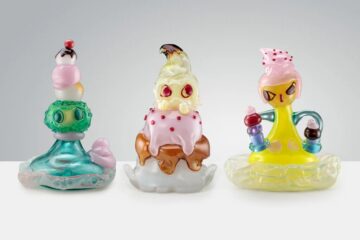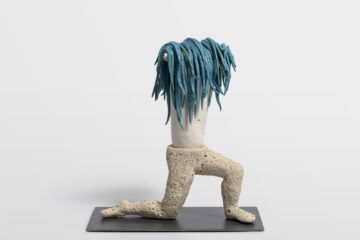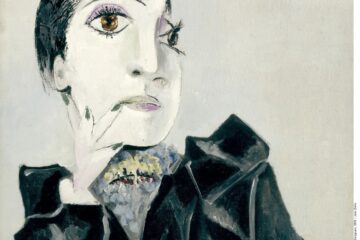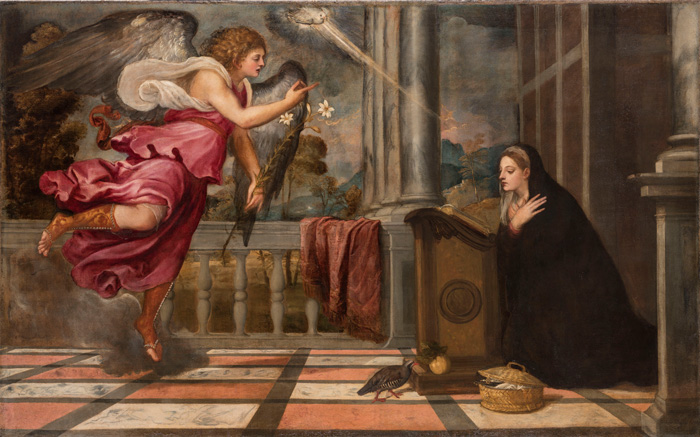
Gerhard Richter, a great master of contemporary painting, in dialogue with a great master of ancient painting, Titian.
This is what happens in the exhibition Titian/Gerhard Richter. Heaven on Earth [Tiziano/Gerhard Richter. Il Cielo sulla Terra], from 7 October 2018 to 6 January 2019, in an evocative context, Palazzo Te in Mantua.
A journey of 17 works, by Titian and Richter, curated by Helmut Friedel, Marsel Grosso and Giovanni Iovane.
The exhibition starts from an almost casual episode: in 1972, during a visit to Venice, Gerhard Richter discovered the painting of the Annunciation by Titian in the Scuola Grande di San Rocco. And he remains literally struck by it.
Richter, then forty and already a sufficiently mature artist, always looking for new sources of inspiration, decides to copy the painting by Titian.
Thus begins an intimate relationship between the two artists, which has lasted for over 40 years.
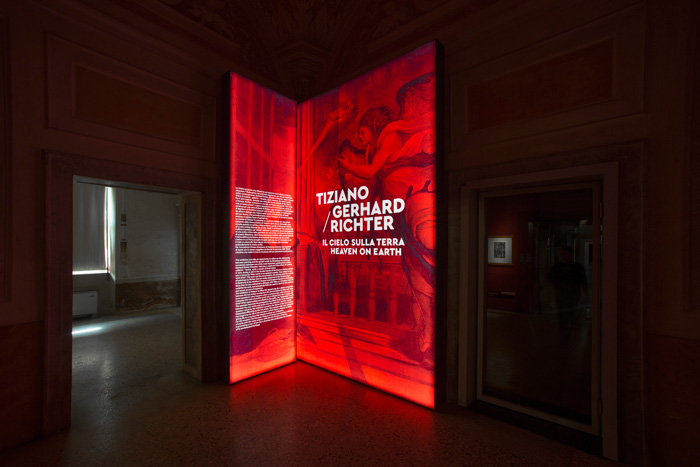
Titian / Gerhard Richter. Heaven on Earth: Titan’s tonal painting
But how did Richter understand and revise Titian’s lesson?
We must go back to the two great “trends” of Italian Renaissance painting, which Vasari had already distinguished.
On the one hand, there is the “Florentine School“, with artists ranging from Botticelli to Michelangelo. In whose painting the “drawing” is pre-eminent. In the works of these artists, in fact, the figures are generally quite distinct from each other, they are surrounded by an evident stroke, the “drawing” in fact, and there is a discrete passage, defined among the various elements.
Each element therefore assumes its own color (as, apparently, it’s natural) and the paintings, as a whole, are a sum of elements colored in a “single“ way, each one different from the others.
On the other side, there is the “Venetian School” which includes artists such as Giovanni Bellini, Giorgione and Tiziano himself. In their works the “color” predominates, and in particular the use of “color tones“. By extending the concept, we can say that in these paintings there is always a dominant light (or, often, many lights) that stretches out on the scene, modifying the “tones“ of the different colors, and, partially, standardizing them.
Just look at a detail of the Annunciation by Titian: the columns that hold the portico.
![Titian, Annunciation, 1539 ca., [detail] Oil on canvas, 166 x 266 cm Venice, Scuola Grande Arciconfraternita di San Rocco](http://www.thephotophore.com/wp-content/uploads/2018/11/tiziano-gerhard-richter-il-cielo-sulla-terra-mantova-011.jpg)
It is clear how the outer columns, those behind, at the farthest point from the observer, are dominated by a golden-brown “tone“. The nearest column to the observer, has a darker “tone“, tending to gray.
This is because the external light (and perhaps also the divine ray that will strike Mary), is stronger outside, while it is weaker inside, where the greater shadow of the arcade tends to “darken” the “tone”, to make it closer to gray.

Diasec mounted giclée print on aluminium composite panel, 125 x 200 cm | Inv. P-12 | Private collection | © Gerhard Richter 2018
Titian / Gerhard Richter. Heaven on Earth: Gerhard Richter’s tonalism
In the painting that Gerhard Richter painted in 1973 (date of the original, whose “printed” copy is exhibited), the light that pervades the painting is uniform towards yellow-ocher.
Richter recovers Tiziano’s “tonal painting” and, with a technicality, we can say that he transforms it into “tonalism“. In fact, “tonalism” is a sort of exasperation of “tonal painting”, in which a single “tone” of light descends over the whole painting.
Titan himself, as he matures, often exacerbates tonal painting, leading it towards tonalism. This is the case of the famous Pope Paul III and His Grandsons (1546). Here the scene is almost totally dominated by the red-brown light reflected by the curtain, which pervades the three men on the scene with its strong color.
Thus Richter, in his Annunciation, simplifies the colors of Titan’s original: the yellow ocher light spreads across the scene and blurs it. The architectures lose the shades of gray and take on those of yellow. The background, which in Titian turned towards the blue, in the painting by Richter moves towards brown. In the foreground there are the angel, with a bright red cassock, and the Virgin Mary, dressed in a deep black.
![Tiziano/Gerhard Richter. Il Cielo sulla Terra, Palazzo Te, Mantova, installation view, Exhibition Design Lissoni Associati - Piero Lissoni, ph Gian Maria Pontiroli [particular of the work: Gerhard Richter, Spiegel, blutrot, 1991 Colour-coated glass, 89 x 92 cm | Inv. 736-4 | Private collection | © Gerhard Richter 2018]](http://www.thephotophore.com/wp-content/uploads/2018/11/tiziano-gerhard-richter-il-cielo-sulla-terra-mantova-007.jpg)
[particular of the work: Gerhard Richter, Spiegel, blutrot, 1991
Colour-coated glass, 89 x 92 cm | Inv. 736-4 | Private collection | © Gerhard Richter 2018]
Titian / Gerhard Richter. Heaven on Earth: the tonalism between figuration and abstraction
Over the years, Gerhard Richter has kept this Renaissance lesson, and proposed its concept both in his figurative and abstract works.
The intuition is so strong that it becomes almost purely “theoretical” in the work Spiegel, blutrot [Mirror, blood red] of 1991.
The work, as the title says, consists of a red mirror, in which the observer, as he approaches, looks at himself in the mirror. So everything that is mirrored takes on a strong dominant “tonal” red. It is as if, from time to time, new paintings have been created, always new works, that take to extremes the red tonality.
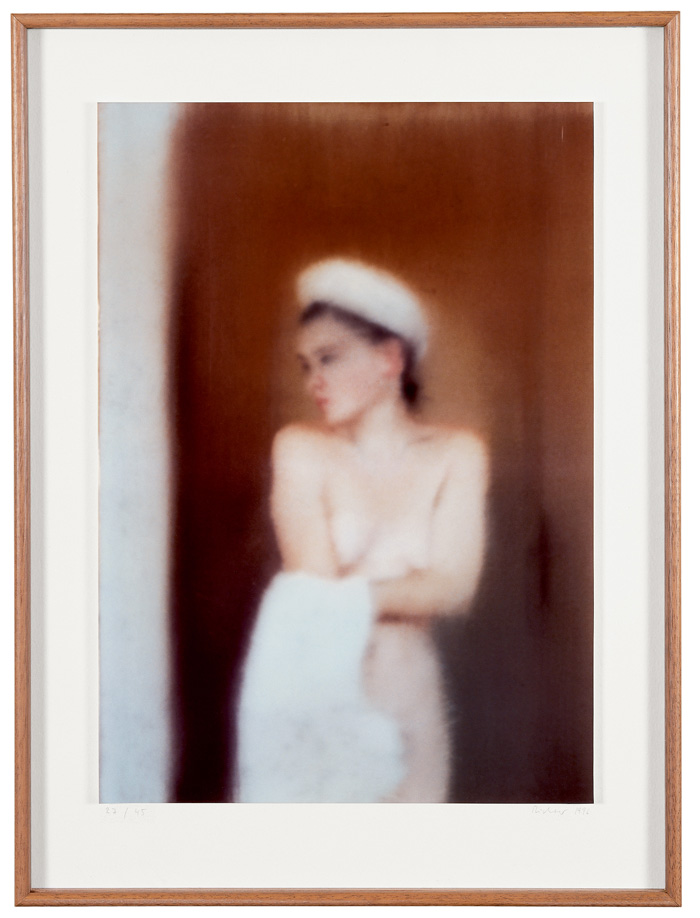
Edizione CR 87 | Prova 1/4 | Cibachrome photograph mounted on cardboard,
52,7 x 37,5 cm | Private collection | © Gerhard Richter 2018
An example of a tonalist figurative work, instead, is the photo of the Kleine Badende [Little Bather] (1996). Made on the basis of the oil painting of the same name realized in 1994, the artist’s wife is presented immersed in a red tone contrasted by the whiteness of a few side elements.
From here we arrive at the most recent abstract works of the German master. These paintings are made by overlapping layers of different colors, and then brushing, on the still fresh paint, a large spatula. In this way the colors blend together, creating ever-changing shapes, but almost always maintaining the dominant “tone” given by one of the colors of the composition. It may be the darker color used, or the last overlaid. Or the color resulting from the mixing of other colors, such as the green that derives from the union of blue and yellow.
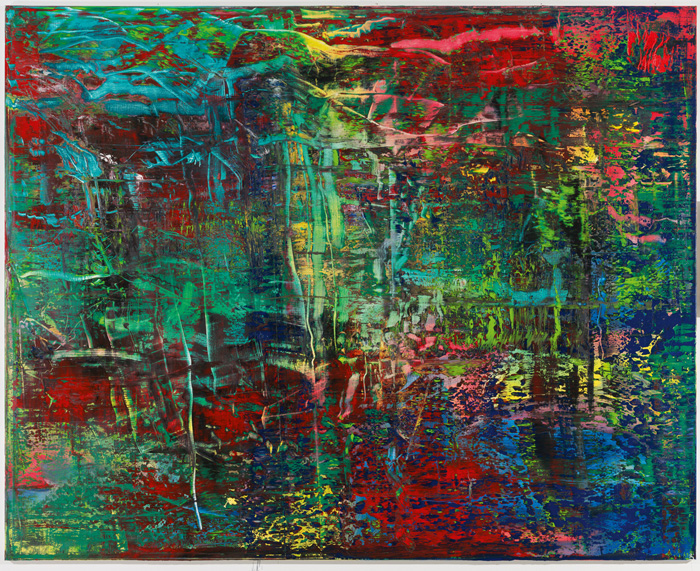
Oil on canvas, 200 x 250 cm | Inv. 946-2 | Private collection | © Gerhard Richter Archive
Thus a “lesson” of five hundred years ago, always finds new forms in which to express itself, always new artistic contexts to be applied.
Great ancient art meets great contemporary art, intertwining themes and meanings. In an important exhibition, in an extraordinary context: not to be missed.
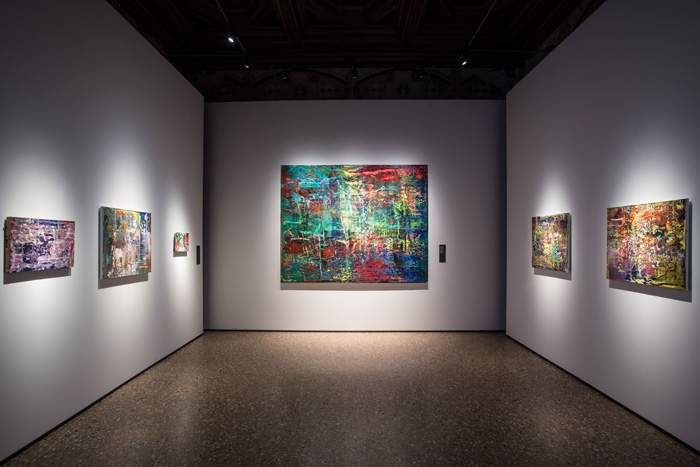
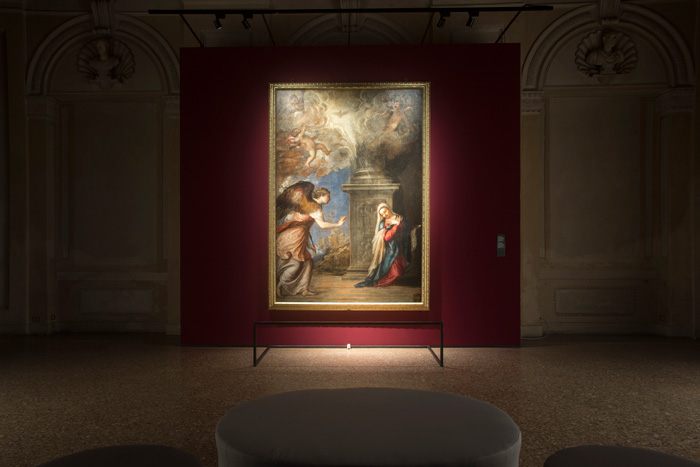
Tiziano/Gerhard Richter. Il Cielo sulla Terra
7 October 2018 – 6 January 2019
Palazzo Te
Mantua, Italy
Text by Domenico Fallacara | the PhotoPhore
Discover: www.palazzote.it
